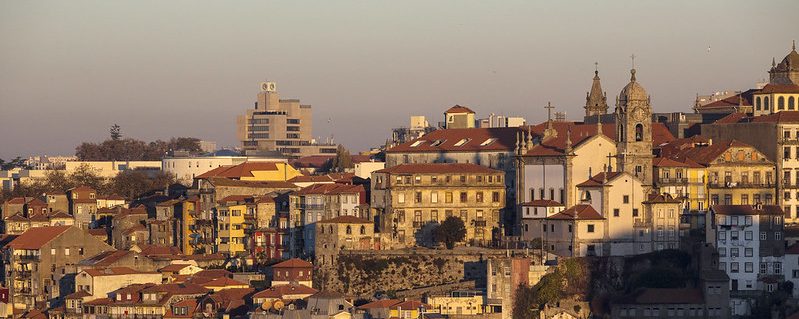BEAUTIFUL PORTO
Porto is the second-largest city in Portugal after the capital Lisbon and one of the major urban areas of the Iberian Peninsula. The city proper has a population of 237,591 and the metropolitan area of Porto, which extends beyond the administrative limits of the city, has a population of 1.9 million (2011) in an area of2,395 km 2 (925 sq mi).
Located along the Douro river estuary in Northern Portugal, Porto is one of the oldest European centres, and its historical core was proclaimed a World Heritage Site by UNESCO in 1996. The western part of its urban area extends to the coastline of the Atlantic Ocean. It's settlement dates back many centuries, when it was an outpost of the Roman Empire. Its combined Celtic-Latin name, Portus Cale has been referred to as the origin of the name “Portugal”, based on transliteration and oral evolution from Latin. In Portuguese, the name of the city is spelled with a definite article o Porto - and this is why its English name evolved from a misinterpretation of the oral pronunciation and referred to as Oporto in modern literature and by many speakers.
In 2014 and 2017, Porto was elected The Best European Destination by the Best European Destinations Agency. Porto is on the Portuguese Way path of the Caminho de Santiago.
One of Portugal's internationally famous exports, port wine, is named after Porto,since the metropolitan area, and in particular the cellars of Vila Nova de Gaia, were responsible for the packaging, transport, and export of fortified wine.
The city’s movida was mentioned in the New York Times, which highlighted the newcultural, touristic and leisure opportunities available in the city. The article “36 Hoursin Porto Portugal”, by the travel journalist Nell McShane Wulfhart, defines Porto as a charming city combines the best of old and new. In 2017, Angelina Villa-Clarke wrote in Forbes that “Porto is one of Europe’s must-sees” .
Porto features a warm-summer Mediterranean climate, with influences of an Oceanic climate. As a result, its climate shares many characteristics with the coastal south: warm, dry summers and mild, rainy winters. Summers are typically sunny withaverage temperatures between 16 °C (61 °F) and 27 °C (81 °F) but can rise to ashigh as 38 °C (100 °F) during occasional heat waves. During such heat waves the humidity remains quite low. Nearby beaches are often windy and usually cooler than the urban areas. Summer average temperatures are a few degrees cooler than those expected in more continentally Mediterranean influenced metropolises.
The city has an extensive bus network run by the STCP (Porto Public Transport Society) which also operates lines in the neighbouring cities. The Porto Metrois a light rail network that runs underground in central Porto andabove ground into the city's suburbs. The network has 6 lines which intersect at the central Trindade station, and reaches seven municipalities within the metropolitan Porto area. The nearest station to the conference venue is “Pólo Universitário”, in Line E (yellow line). The system uses the “Andante” ticketing system. Machines in stations issue and can recharge Andante Azul - blue; tickets. The Porto Metro operates on a proof-of-payment system. Tickets must be validated before travel by scanning them in front of the yellow machines located in stations. A validated occasional ticket allows for unlimited travel within a specified time period, currently 1 hour for the minimum 2-zone ticket. STCP bus routes and some other bus routes currently accept Andante.

HOW TO GET HERE
International Access
Francisco Sá Carneiro Airport (OPO) or simply Porto Airport is an international airport located 11 km (6.8 mi) northwest of the centre of Porto. The airport is currently the second-busiest in the country, after Lisbon Airport and before Faro Airport. The airport is a base for EasyJet, Ryanair, TAP Air Portugal and its subsidiary TAP Express. It operates flights to and from many European and some non-European destinations, with several flights daily to cities like Madrid, Paris, Frankfurt or London.
Airports Council International Airport Service Quality Awards voted the airport Best Airport in Europe in 2007. Additionally, it has placed in the top three of Best Airport in Europe a further ten times – winning second place in 2010 and 2017, and third place in 2006, 2008, 2009, 2011, 2013, 2014, 2015 and 2016.
Accessibility: The airport is served by Line E of the Porto Metro. The service links the airport to Porto city centre, and to high-speed trains at Campanhã railway station. STCP buses also link the airport and the city. There is also a bus that operates all night from Porto city centre to the airport. Sá Carneiro airport is accessible via the A41 and A28 motorways, but also the EN13 highway (using the EN107 access way). These roadways lead to drop-off and pick-up areas and short and long-stay car parks.
Railway
Porto is connected to Portugal’s capital Lisbon, and other main cities in the country, by fast trains “Alfa-Pendular” and Intercity. A direct connection to Vigo in Galicia-Spain is also operated from Porto.

